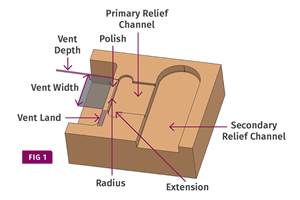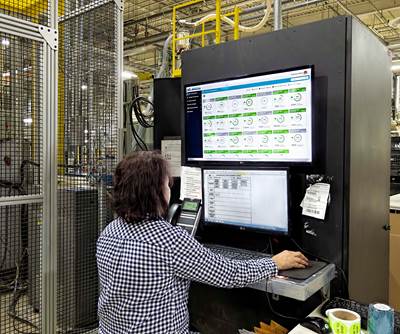Extrusion & Thermal Properties: Not Just for the Lab Guys
Do you really need to know how thermal properties of polymers affect extrusion?
Do you really need to know how thermal properties of polymers affect extrusion? Isn’t this stuff just for the guys in the lab? Yes and no. To troubleshoot many processing issues, you’ll need at least a basic understanding of how polymer thermal properties impact your process—from the feed hopper through the final product dimensions. Much of this data is hard to come by. But to understand many aspects of equipment performance, you should bone up on key polymer properties that usually aren’t available in data sheets:
- Viscosity vs. shear rate data at several temperatures in the processing range.
- Specific heat.
- Thermal conductivity.
- Solid and melt density or their specific weights.
- Melting point or processing temperature.
Viscosity affects melting rate, output, melt temperature and die flow, among other things. The higher the viscosity, the higher the melting rate in the screw, extruder power usage, discharge pressure, and melt temperature. In order to determine the viscosity ranges of your materials, you’ll need data from a rheometer, which applies differing loads to develop various shear rates. The rheometer can also be run at various temperatures to show how polymer viscosity responds to changes in both shear rate and temperature. Polymers such as PP are quite shear sensitive, meaning the higher the relative velocities in the screw or flow channel, the more the viscosity decreases. Other polymers such as PET are more temperature sensitive, meaning the viscosity changes a lot with temperature. Some polymers are considered to be both shear and temperature sensitive.
Specific heat defines how much energy it takes to raise the temperature of a polymer. HDPE, for example, requires an average of 0.55 BTU/lb-°F, while HIPS requires 0.4 BTU/lb-°F. Therefore, it takes almost 40% more energy to raise the temperature of 1 lb of HDPE than 1 lb of HIPS. This means more drive power is required to process HDPE than HIPS at the same lb/hr and the same melt temperature. It also takes 40% more cooling capacity to extract that heat from HDPE, which means larger cooling rolls for sheet and flat film and longer spray tanks for pipe, tubing, and profiles.
Thermal conductivity is the ability of the polymer to conduct heat. Polymers with high thermal conductivity melt easier and cool faster. For example, HDPE has an average thermal conductivity of 0.15 BTU/ft-°F-hr, while HIPS is 0.08 BTU/ft-°F-hr. Because of its higher thermal conductivity, HDPE melts more easily from heat transferred from the surrounding melted polymer or from the barrel. Likewise, it is more difficult to cool HIPS of the same thickness and temperature because of its lower thermal conductivity.
Solid and melt density are particularly important in screw design and extruder sizing. Some polymers have a modest change in density as they soften or melt, while others change significantly. Typically, crystalline polymers have a much larger change in density during processing than amorphous polymers. HDPE (crystalline) density changes 18% from 0.95 to 0.78 g/cc when melted, while HIPS (amorphous) changes only 15% from 1.04 to 0.88 g/cc when raised to the processing temperature. This means that a specific screw design would be expected to have a slightly lower lb/hr output with HDPE than HIPS, since screw output is volumetric. This change in density has to be calculated into a screw design.
Melting point can be confusing, as only crystalline polymers have a defined melting point, while amorphous polymers simply soften as they get hotter. As a result, it is best to compare polymers by their typical extrusion processing temperatures. By multiplying the specific heat and the temperature rise necessary to heat polymers to their processing temperature, you can estimate the relative power required to process various polymers. This data is important in the design of the screw and the sizing of the extruder drive.
Thermal diffusivity is a combination of the thermal conductivity divided by the specific weight and specific heat. Specific weight is the density multiplied by 64.43 lb/ft³, which is the weight of a cubic foot of water. Diffusivity combines three thermal properties to provide a reference for the energy necessary to reach the processing temperature at a specific thickness and the cooling necessary for removing that heat. For example, the diffusivity for HDPE and HIPS are 0.0046 and 0.0031, respectively. This result shows that it is almost 50% more difficult to add or remove heat from HIPS than HDPE.
The more you know about polymer properties the easier it will be to quickly find the correct answer to many processing problems.
About the Author
Jim Frankland is a mechanical engineer who has been involved in all types of extrusion processing for more than 40 years. He is now president of Frankland Plastics Consulting, LLC. Contact jim.frankland@comcast.net or (724)651-9196.
Related Content
How to Select the Right Cooling Stack for Sheet
First, remember there is no universal cooling-roll stack. And be sure to take into account the specific heat of the polymer you are processing.
Read MoreBack to Basics on Mold Venting (Part 2: Shape, Dimensions, Details)
Here’s how to get the most out of your stationary mold vents.
Read MoreHow to Select the Right Tool Steel for Mold Cavities
With cavity steel or alloy selection there are many variables that can dictate the best option.
Read MoreBack to Basics on Mold Venting (Part 1)
Here’s what you need to know to improve the quality of your parts and to protect your molds.
Read MoreRead Next
See Recyclers Close the Loop on Trade Show Production Scrap at NPE2024
A collaboration between show organizer PLASTICS, recycler CPR and size reduction experts WEIMA and Conair recovered and recycled all production scrap at NPE2024.
Read MoreFor PLASTICS' CEO Seaholm, NPE to Shine Light on Sustainability Successes
With advocacy, communication and sustainability as three main pillars, Seaholm leads a trade association to NPE that ‘is more active today than we have ever been.’
Read MorePeople 4.0 – How to Get Buy-In from Your Staff for Industry 4.0 Systems
Implementing a production monitoring system as the foundation of a ‘smart factory’ is about integrating people with new technology as much as it is about integrating machines and computers. Here are tips from a company that has gone through the process.
Read More
.jpg;width=70;height=70;mode=crop)














